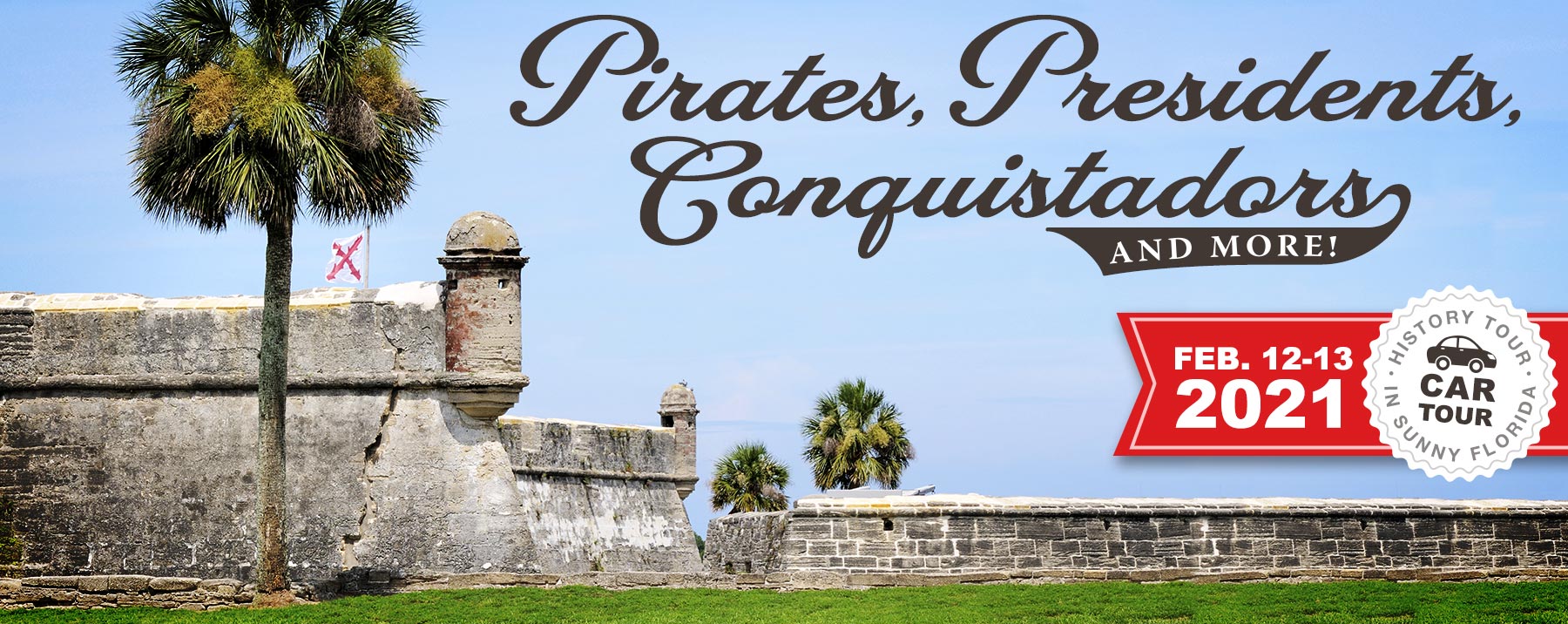
Event Summary
![]() oin Landmark Events and historian Bill Potter as we explore the ancient sites of northeastern Florida, redolent with the sea breezes of the Atlantic and steeped in a providential history that helped create the English civilization that became embedded north of Florida and brought about the abandonment of the outposts of Spain’s Empire in North America. We will tell the stories on site of the Castillo de San Marcos in St. Augustine and the French Huguenot colony at Jacksonville, Ft. Caroline. We will remember the courageous Reformed settlers who brought the Gospel to the natives of the region and their subsequent extermination by the Spanish for the capitol crime of rejecting the Catholic Church and following the Calvinist Reformation. We will examine the lives and times of fearless conquistadors, superstitious explorers seeking the fountain of youth, the ferocious no-holds-barred Scots-Irish General Andrew Jackson who seized Florida and would not give it back, and the natives who suffered through all the invasions and fought a war with the United States that was never concluded!
oin Landmark Events and historian Bill Potter as we explore the ancient sites of northeastern Florida, redolent with the sea breezes of the Atlantic and steeped in a providential history that helped create the English civilization that became embedded north of Florida and brought about the abandonment of the outposts of Spain’s Empire in North America. We will tell the stories on site of the Castillo de San Marcos in St. Augustine and the French Huguenot colony at Jacksonville, Ft. Caroline. We will remember the courageous Reformed settlers who brought the Gospel to the natives of the region and their subsequent extermination by the Spanish for the capitol crime of rejecting the Catholic Church and following the Calvinist Reformation. We will examine the lives and times of fearless conquistadors, superstitious explorers seeking the fountain of youth, the ferocious no-holds-barred Scots-Irish General Andrew Jackson who seized Florida and would not give it back, and the natives who suffered through all the invasions and fought a war with the United States that was never concluded!
Join Us in Sunny Florida!
![]() They’ve done all the work for you! Just show up and enjoy each of the amazing venues, and soak in the Biblical interpretations and rich fellowship. You won’t regret it!” —Jessica K.
They’ve done all the work for you! Just show up and enjoy each of the amazing venues, and soak in the Biblical interpretations and rich fellowship. You won’t regret it!” —Jessica K.
St. Augustine Pirate Museum
Fort Caroline National Memorial
Ponce de Léon’s Fountain of Youth Archaeological Park
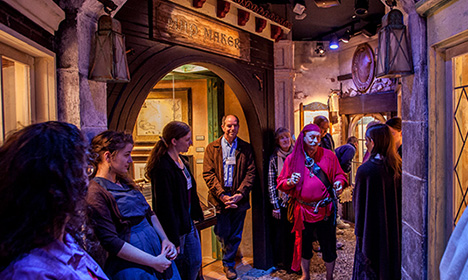
St. Augustine Pirate Museum
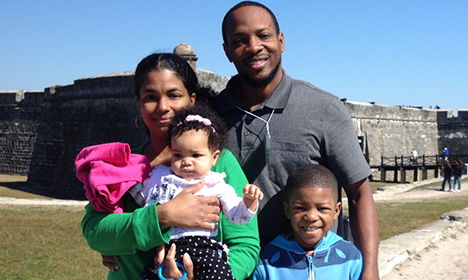
Castillo de San Marcos
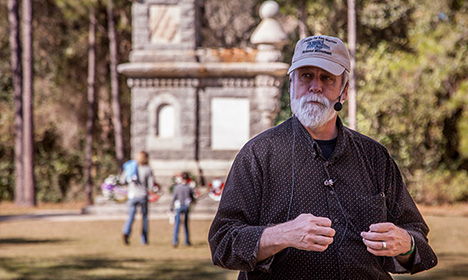
Historian Bill Potter
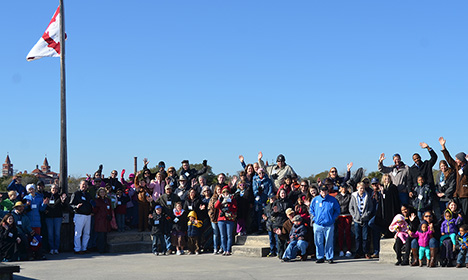
Rich Christian Fellowship
![]() Landmark Events does an amazing job at weaving together our Christian heritage with the broader history in an educational and fun way for everyone in the family! You won’t be disappointed!” —Darrell S.
Landmark Events does an amazing job at weaving together our Christian heritage with the broader history in an educational and fun way for everyone in the family! You won’t be disappointed!” —Darrell S.
Tour Highlights
 y 1492 the last Muslims fleeing the Inquisition left the coasts of Iberia, setting off a train of events unforeseen by any but the God of Providence, Lord of the Earth. The House of Aragon and the House of Castile had earlier united in the marriage of cousins, 17-year-old King Ferdinand and 18-year-old Queen Isabella, combining the kingdoms that eventually led to the modern nation called Spain. In 1492 they gave approval for a skilled navigator, designated “Admiral of the Oceans,” Christopher Columbus, to seek a sea route to the Far East by sailing westward across the Atlantic Ocean.
y 1492 the last Muslims fleeing the Inquisition left the coasts of Iberia, setting off a train of events unforeseen by any but the God of Providence, Lord of the Earth. The House of Aragon and the House of Castile had earlier united in the marriage of cousins, 17-year-old King Ferdinand and 18-year-old Queen Isabella, combining the kingdoms that eventually led to the modern nation called Spain. In 1492 they gave approval for a skilled navigator, designated “Admiral of the Oceans,” Christopher Columbus, to seek a sea route to the Far East by sailing westward across the Atlantic Ocean.
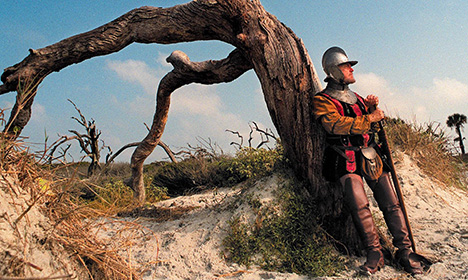
Ponce de León
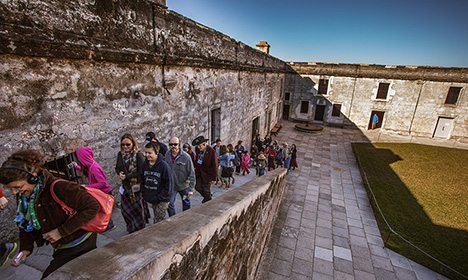
Castillo de San Marcos
While the 16th Century would become the era of the Reformation, Europe would also witness the rise of the mighty empire of Spain that would encircle the globe, conquer ancient civilizations, and brook no successful challengers to its professional, arrogant, and rapacious armies. The explorers launched out into the oceans, closely followed by the conquistadors and the missionary priests of the Roman Catholic Church, baptizing the conquered peoples and leaving a cultural influence that continues to thrive in South America, Central America, and the American southwest.
The legacy of Spanish conquest still lies embedded in the oldest continuously inhabited place in the continental United States, St. Augustine. Founded on “St. Augustine’s Day” in the liturgical calendar, a great fortress known as Castillo de San Marcos (The Castle of St. Mark) arose, to tower over the settlement both as a protection for the Spaniards defending the frontiers, as well as a potential launching pad for the further conquest of North America.

St. Augustine Pirate Museum
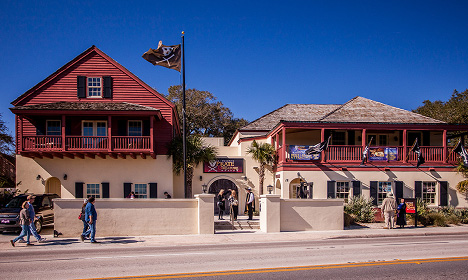
St. Augustine Pirate Museum
Join historian Bill Potter as we explore the ancient sites of northeastern Florida, redolent with the sea breezes of the Atlantic and steeped in a providential history that helped create the English civilization that became embedded north of Florida and brought about the abandonment of the outposts of Spain’s Empire in North America. We will tell the stories on site of the Castillo de San Marcos in St. Augustine and the French Huguenot colony at Jacksonville, Ft. Caroline. We will remember the courageous Reformed settlers who brought the Gospel to the natives of the region and their subsequent extermination by the Spanish for the capitol crime of rejecting the Catholic Church and following the Calvinist Reformation. We will examine the lives and times of fearless conquistadors, superstitious explorers seeking the fountain of youth, the ferocious no-holds-barred Scots-Irish General Andrew Jackson who seized Florida and would not give it back, and the natives who suffered through all the invasions and fought a war with the United States that was never concluded!
Event Speakers
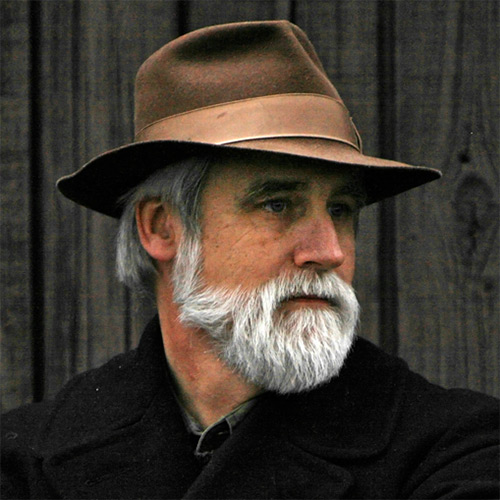
Bill Potter
An experienced historian and avid bibliophile, Bill Potter combines a lifelong study of American history with an uncommon ability to captivate audiences of all ages as he traces the providential acts of God throughout the ages. Mr. Potter has taught history in high schools and colleges, has led many tours of American and European historical sites and brings to each event a wealth of experience and knowledge. An experienced researcher and writer, Mr. Potter possesses a practical knowledge of antiquarian books, documents, and artifacts and has published several short books and has penned many articles and book reviews for publication. Bill has earned a well-deserved reputation as a man gifted in communicating the story of God’s providential hand in American history. As a father of eight children, he appreciates the necessity of passing on to the succeeding generations the richness of both our regional and national history. He and his wife, Leslie, reside in Virginia.
Event Schedule
Friday, February 12
| 9:00am | 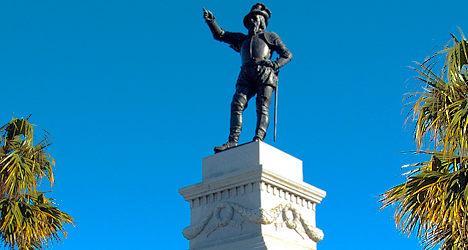 |
Ponce de León’s Fountain of Youth Archaeological Park 11 Magnolia Avenue, St. Augustine, FL 32084 (Fountain of Youth has a nice picnic area if you want to bring your lunch on Friday. They also have a small snack bar on site or you can get something en route to Jacksonville. No food is available at Ft. Caroline.) |
|
||
| 1:00pm | 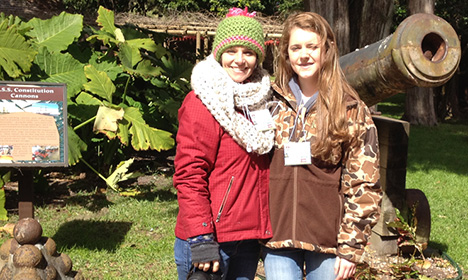 |
Fort Caroline National Memorial (meet at visitors center) 12713 Fort Caroline Road, Jacksonville, FL 32225 |
|
||
|
4:30pm |
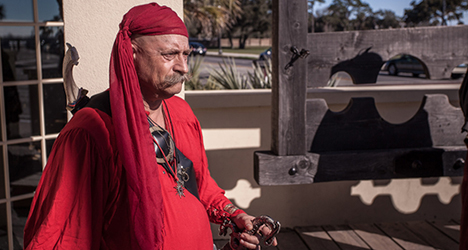 |
St. Augustine Pirate & Treasure Museum 12 South Castillo Drive, St. Augustine, FL 32084 |
|
7:00pm |
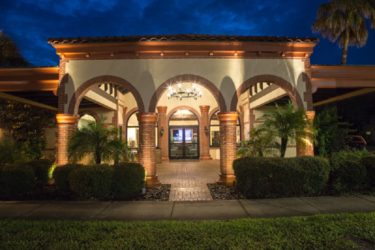 |
Pizza, Andrew Jackson, and Fellowship – Holiday Inn Express & Suites St. Augustine North 2300 State Road 16, St. Augustine, Florida 32084 BYO Dinner with discussion and fellowship. |
Saturday, February 13
| 9:00am | 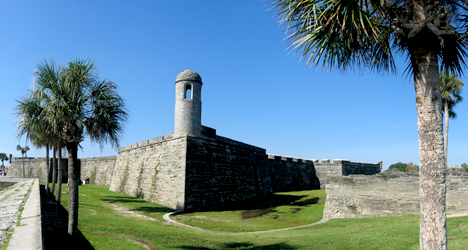 |
Castillo de San Marcos (meet outside ticket kiosk) 1 South Castillo Drive, St. Augustine, FL 32084 |
| Lunch on your own. Picnic or dine in at local diners. | ||
|
||
| 11:00am |
 |
The Battle of Olustee Civil War reenactment has been cancelled. We will be taking a wonderful walking tour of the Historic District of St. Augustine in the afternoon. The tour will conclude by 4:30 Saturday afternoon. |
| Note: Times are subject to change. |
Accommodations
For your convenience, Landmark Events will has secured a block of rooms at the:
Holiday Inn Express & Suites St. Augustine North
2300 State Road 16
St. Augustine, Florida 32084
Call (877) 859-5095 or (904) 824-5151 to make reservations and mention Landmark Events to secure rates of $95 for February 11 and $125 for February 12 for a room with 2 queen beds and grab-n-go breakfast. There is also a limited number of rooms with 2 queen beds and a pullout sofa for a slightly higher rate. Wi-Fi and parking are free. Make your reservations by January 27 to secure this special rate.
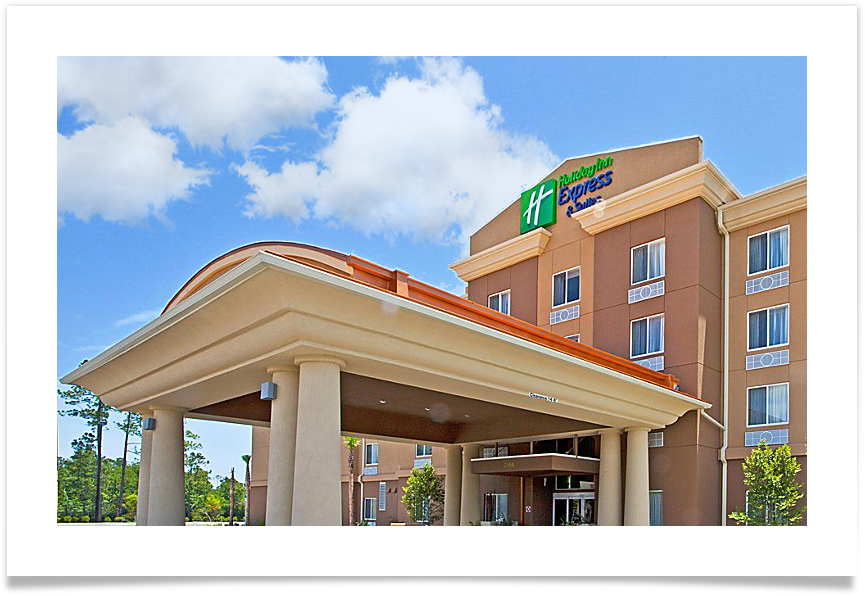
The Friday evening meal/fellowship will be held in the meeting room of the Holiday Inn Express & Suites.
Please note: Our choice of hotels is limited to properties that have a meeting space adequate to accommodate our group. However, guests are free to stay wherever best meets their facility needs and budget.
*** If you are planning on staying Saturday night, we suggest you reserve your room as soon as possible as the Daytona 500 NASCAR race is Sunday and there is a big demand for rooms Saturday night. Our tour ends Saturday afternoon at the Battle of Olustee reenactment, which is about 75 minutes north of St Augustine, so many folks continue north toward home Saturday evening.
Study Prep
Key People
King Ferdinand & Queen Isabella
Christopher Columbus
Ponce de León
Hernando de Soto
Admiral Gaspard II de Coligny
Jean Ribault
Pedro Menendez de Aviles
Edward Teach
Sir Francis Drake
General Andrew Jackson
Chief Osceola
General Truman Seymour
General Joseph Finegan
Key Issues and Topics
Spanish Empire
Conquistadors: Missionaries or Murderers?
Huguenots and the French Reformation
Fountain of Youth (man’s constant search for immortality)
Motivations for Exploration: God, Gold, and Glory
Differences in Colonization Theory: English, French, Spanish
Role of Piracy in Atlantic Coastal history
Piracy in the Cinema: Romantic Misfits?
A Biblical Analysis of Piracy vs. Letters of Marquee/Raiding the Spanish Main
Florida’s Strategic Role in the Civil War
Bibliography / Recommended Reading List
Pirates, Puritans, and the Perils of the High Seas, by Captain Charles Johnson and Puritan John Flavel, Edited by R. A. Sheats
Under the Black Flag: The Romance and the Reality of Life Among the Pirates, by David Cordingly
Spain in America, by Charles Gibson
Londonniere & Fort Caroline, by Charles E. Bennett
Knights of Spain, Warriors of the Sun, by Charles Hudson
Confederate Florida: The Road to Olustee, by William H. Nulty

- Q: What credible evidence is there that Ponce de Leon was searching for a “fountain of youth.”
A: There is no credible evidence. Spanish historians wrote it back into the history as supposition.
- Q: Why did French Roman Catholic naval Captain Dominique de Gogues set out to kill fellow-Catholic Spaniards in Florida to avenge the death of Huguenot Protestants?
A: The Spaniards had wiped out the Protestant colony because they were also French, and they wanted no European interlopers threatening their plans to colonize North America, be they Protestant or Catholic. De Gogues was a proud Frenchman who hated Spaniards.
- Q: Why did Edward Teach wear lighted candles in his beard?
A: Better known as “Blackbeard,” it gave him a more ferocious aspect to frighten his enemies and enhance his reputation.
- Q: Why did the coquina shell façade of Fort San Marcos prove so effective in resisting attack?
A: It was pliable to a certain extent and could absorb cannon balls well.
- Q: Why did the marriage of a pair of teenage aristocrats have such a positive impact on the advance of Spain into the New World?
A: Ferdinand and Isabella united the Houses of Aragon and Castile and drove out of Spain the last of the Muslims, enabling them to unite the country and invest in overseas expansion, beginning with Columbus.
- Q: Why did the Huguenots desire to set up plantations in the New World?
A: They had secured a national leader in the person of Admiral de Coligny, who promoted French Protestant missions, economic prosperity, and glory for God and France against Spanish rivals.
- Q: How did the largest Civil War battle in Florida come to be fought at Ocean Pond (Olustee)?
A: The Union army was trying to seize or destroy the railroad from Jacksonville to Tallahassee, perhaps even to capture the capitol. Olustee was a stop on that railroad line where the Confederates decided to make a stand.
- Q: Why was such a seeming backwater like Florida so strategically important to the Confederacy?
A: Florida offered many inlets for Confederate blockade runners to slip in and out. It provided essential supplies to feed the armies in both major theaters of the war, especially in the last year of the conflict.
- Q: Why were the Seminoles so successful in preventing victory for the United States army over them in the 19th Century?
A: The Seminoles had brave braves and leaders like Osceola who used the swamps and forests to hide and make raids. They posed as tourists in the winter to confuse the army.
- Q: What part did Andrew Jackson’s incursions into Florida play in the United States acquiring the land from Spain?
A: He showed how weak they were by attacking them and intimidating their governor, with impunity. He threatened them, hanged British spies, and violated all known laws regarding the invasion of enemy soil.


 Youth (5-16)
Youth (5-16)  Adult (17+)
Adult (17+)  Family (4 Members)
Family (4 Members)  Add’l Family Members
Add’l Family Members 

